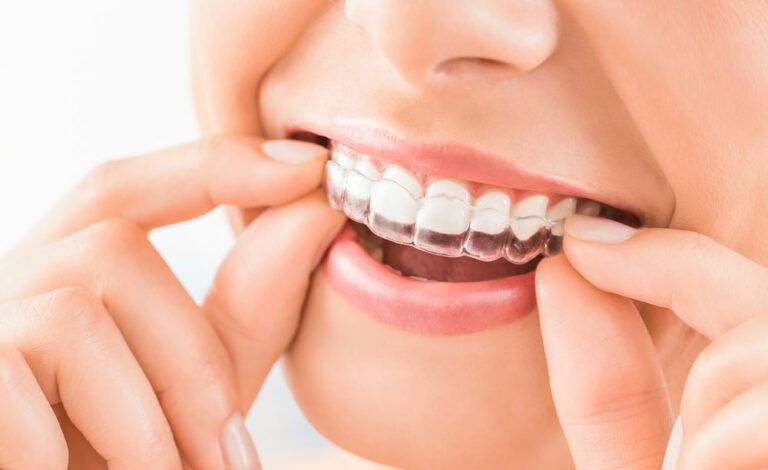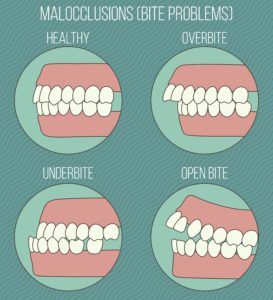Orthodontics & Invisalign

Orthodontics have been around for almost as long as general dentistry and their advancement has closely followed the advancement of modern dentistry. With this, orthodontic options have become more advanced in terms of their application and appearance. This variety makes it easier for people of all ages to seek orthodontic treatment to correctly align their teeth and bite. Currently, the two most popular types of orthodontic treatment include traditional wire braces and Invisalign.
Did You Know?
Orthodontics have been around for thousands of years. In fact, Egyptian mummies have been found with metal bands around their teeth and Hippocrates even wrote about teeth irregularities. In 1728, a more formal approach of metal braces came to light with Pierre Fauchard who wrote a book detailing metal being tied to teeth to correctly align them.
Frequently Asked Questions:
Do I need orthodontic treatment?

You may need orthodontic treatment if you have teeth that are overcrowded, protrusive, improperly spaced, or that have gaps between them. You may need also orthodontic treatment if you have an overbite, underbite, or crossbite.
Although most people focus on the aesthetic benefits of having straight teeth and a properly aligned bite, there are also several oral health benefits. Crooked teeth can cause a range of dental health problems including: tooth decay, gum disease and recession, premature wear, and TMJ problems. Not only does orthodontic treatment reduce the likelihood of developing these issues, but it improves the appearance of your smile.
To find out more about what orthodontic treatment can do for you, schedule a consultation with Dr. Jerry Kronquist and Dr. Amanda Rae Kronquist of Sunset Dental Group today.
How does orthodontic treatment work?
Orthodontic treatment works by exerting a steady, direct force to your teeth. Over time, this constant pressure causes the teeth to gradually shift as the bone around them breaks down. Once in their new position, the pressure is removed and the bone can regrow. The new bone growth will strengthen the teeth and hold them in their new position.
Both traditional metal braces and Invisalign use this mechanism to achieve results. With traditional metal braces, the arch wire exerts pressure to move the teeth and is changed out every few weeks to continuously move them. With Invisalign, the aligner itself exerts pressure and is changed out every few weeks to keep the teeth moving.
Which orthodontic treatment is right for me?

As mentioned before, the two most popular types of orthodontic treatment are traditional wire braces and Invisalign. At Sunset Dental, we offer both metal braces and Invisalign, however the type of orthodontic treatment you choose will depend on a number of factors including the severity of your case, lifestyle choices, financial budget, and aesthetic preferences.
At a glance, traditional wire braces are not as aesthetically pleasing and may cause slightly more discomfort than Invisalign, however they can be more affordable and can remedy more severe cases when compared to Invisalign. Conversely, Invisalign does not require as many lifestyle changes and offers a greater level of flexibility than traditional wire braces. During your consultation, our dentists will discuss your individual case and which option would work best for you.
What can I expect when receiving orthodontic treatment from Sunset Dental?
Your expectations for orthodontic treatment will vary depending on the type of treatment you choose. For both traditional braces and Invisalign, you will need to attend regular appointments so that our dentists can monitor your progress and make adjustments as needed. For traditional metal braces, it is often the arch wire that is adjusted, while for Invisalign you will simply receive a new aligner every few weeks.
Once your teeth begin shifting, you may experience some minor discomfort with both traditional metal braces and Invisalign. This is due to the pressure being exerted on your teeth. In most cases, this will fade within a day or two and can be remedied with over the counter pain medications if needed. If you have traditional wire braces, you may also experience some mouth irritations while the soft tissues adjust to the new hardware. Our dentists will provide you with plenty of dental wax to protect your mouth during this transition.
With traditional wire braces, you will also have temporary diet restrictions during your treatment. These dietary restrictions revolve around avoiding foods that are hard, sticky, or chewy because they can damage the brackets and wires, ultimately affecting the treatment. Since Invisalign is removable, these dietary restrictions will not apply for Invisalign treatment.
How do I care for my orthodontic appliances?
Both types of orthodontic appliances will require that you care for them. Because they are attached to your teeth, you will care for traditional wire braces like you would your natural teeth. With Invisalign, however, you will need to take additional steps to clean your aligners every time they are removed from your mouth. You will also need to take special care to always store them in their protective case when they are not in their mouth to prevent them from becoming lost or damaged.
No matter what method you use, good oral habits are essential. These include twice daily brushings and once daily flossing. You should also brush after meals to remove any debris from your teeth, whether you have traditional braces or Invisalign.
How long will my orthodontic treatment last?
How long your orthodontic treatment lasts will mostly center around how severe your case is when you begin treatment. Certain cases may require more movement than others, meaning that your treatment time can be longer. If you are using Invisalign, the treatment time also depends upon whether or not you are wearing your aligners for the recommended amount of time. If you do not wear your aligners as directed, your teeth will not move properly and the overall treatment can take longer.
The average length of orthodontic treatment, regardless of method, is about 1-2 years. When you compare Invisalign to traditional braces, Invisalign has a treatment length of 12-18 months as compared to braces at 1.5-3 years. However this is only because the cases Invisalign is able to treat are much less severe than cases that traditional braces can treat. Overall, the type of method will not affect the speed of treatment.
What happens once my orthodontic treatment is complete?
Once your orthodontic treatment is complete, you will need to wear a retainer. Both wire braces and Invisalign require retainers post-treatment to hold your teeth in place. This is important because it allows new bone to form around the newly moved teeth to hold them in position permanently. Not wearing a retainer can cause teeth to shift and negatively affect the success of treatment.

To obtain your perfect smile with orthodontic services, schedule a consultation with Dr. Jerry Kronquist and Dr. Amanda Rae Kronquist of Sunset Dental Group today. Sunset Dental Group serves Santa Ana and other central Orange County communities.